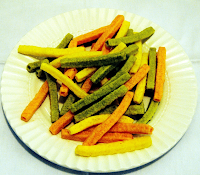My daughter and I decided to make a healthier version of Reese's Peanut Butter Cups today. I found a recipe I liked a while back at Tessa the Domestic Diva's web site. She calls these Healthy Paleo "Peanut Butter" Cups. I modified the original recipe some and we used almond butter and a little bit of peanut butter instead of sunflower seed butter as in the original recipe. These are very delicious but they need to harden in the freezer otherwise they are little bit too runny. Almond butter is little more runny than some other nut butters so you can use any nut butter you like if you want them more firm. I don't mind keeping them in the freezer since it is warm here in California and it tastes great eating cool nut butter cups. We just let them defrost a little before we eat them. The original recipe also calls for 1/2 teaspoon vanilla but we forgot to put it in and I couldn't tell the difference.
What we used
- 1 cup nut butter. I used almond butter with a tiny bit peanut butter, but the original recipe calls for sunflower seed butter.
- 1/2 cup coconut oil
- 1/4 cup honey.
- 1/2 teaspoon salt. We used Pink Himalayan salt
- 1 1/2 cup chocolate chips
How we made them
- We blended all the ingredients until smooth in a mixer. (Not the chocolate)
- We melted the chocolate in a water bath (we don't use a microwave)
- We put the melted chocolate in paper liner and brushed chocolate on the sides and put in the fridge to harden before we added the nut butter mix. We let the mixture harden some in the freezer before we added rest of the melted chocolate on top.
These nut butter cups are very delicious but they need to be eaten cold otherwise the filling is a little bit runny. You can experiment and add any nut butter, I used natural almond butter and it is more runny since it doesn't have hydrogenated oils in it. I will definitely make these nut butter cups again.
Oh, you might want to use smaller paper liners than what we used. Natural nut butters are filling so these cups are big enough to split with two people.
------------------------------------------------------------------------------------------------------------
Johanna is an aromatherapist and she is passionate about educating people about health, essential oils, real food, natural remedies, and nutrition so they make healthier choices in their lives.
Follow Johanna on twitter and facebook for more health tips and information.
This post is linked to:
Fight Back Friday, Sunday School Blog Carnival, Homemade Mondays, Natural Living Monday, Mop it Up Monday, Mama Moments Monday, Fat Tuesday, Healthy Tuesday Hop, Titus 2sdays, Titus 2 Tuesday, Domestically Divine, How to Tuesday, WFMW, The Mommy Club, Wildcrafting Wednesday, Healthy 2Day Wednesday, Wellness Wednesday, Party Wave Wednesday, Homemaking Link Up, Frugal Days, Sustainable Ways, Adorn From Above, The Busy Bees, Natural Living Link Up, Simple Lives Thursday, All Things Thursday, Eco-Kids Tuesday, The Homeacre Hop, Tuesday Greens, Real Food Wednesday










